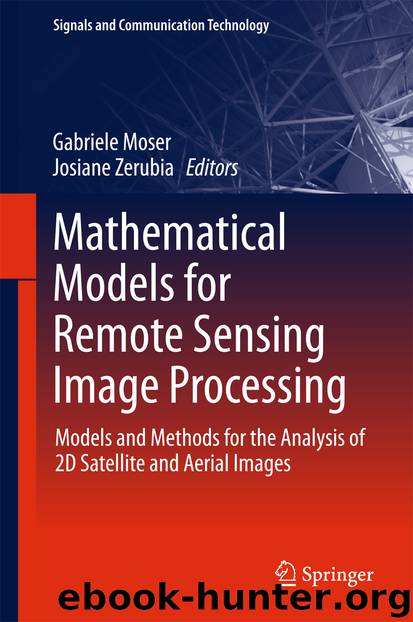Mathematical Models for Remote Sensing Image Processing by Gabriele Moser & Josiane Zerubia

Author:Gabriele Moser & Josiane Zerubia
Language: eng
Format: epub
Publisher: Springer International Publishing, Cham
(5.72)
where indicates a position in frequency, and represents the decomposition result around the spatial and frequency locations and . The application of a Fourier transform to (5.72) shows that the spectrum of is given by the product of the original signal spectrum and the transform of the analyzing function g shifted around the frequency vector :
(5.73)
It is clear from Eqs. (5.72) and (5.73) that this time-frequency approach may be used to characterize, in the spatial domain, behaviors corresponding to particular spectral components of the signal under analysis, selected by the analyzing function g. Among the wide variety of existing TF analysis methods, the simple atomic decomposition selected in this study presents some interesting properties. It is linear, and hence preserves the coherence and energy of signals, it is not affected by artifacts related to cross-terms and may be inverted, i.e., depending on the analyzing function g, may be reconstructed from a set of TF samples , provided that some sampling conditions in spatial and spectral domains are satisfied. The resolutions of the analysis in space and frequency are not independent, and their product is fixed by the Heisenberg–Gabor uncertainty relation, given in 1-D by [41], .
In practice the simple SAR image model given in (5.70) needs to be completed in order to account for additional weighting terms, mainly due to the antenna pattern and side-lobe reduction functions, as [42] with . The synopsis of the TF decomposition based on the spectral definition on (5.73) is given in Fig. 5.7.
Fig. 5.7Synopsis of the proposed Time-Frequency decomposition of a mono-dimensional SAR signal
Download
This site does not store any files on its server. We only index and link to content provided by other sites. Please contact the content providers to delete copyright contents if any and email us, we'll remove relevant links or contents immediately.
Algorithms of the Intelligent Web by Haralambos Marmanis;Dmitry Babenko(8522)
Test-Driven Development with Java by Alan Mellor(7395)
Data Augmentation with Python by Duc Haba(7296)
Principles of Data Fabric by Sonia Mezzetta(7042)
Learn Blender Simulations the Right Way by Stephen Pearson(6977)
Microservices with Spring Boot 3 and Spring Cloud by Magnus Larsson(6799)
RPA Solution Architect's Handbook by Sachin Sahgal(6210)
Hadoop in Practice by Alex Holmes(6031)
The Infinite Retina by Robert Scoble Irena Cronin(5909)
Jquery UI in Action : Master the concepts Of Jquery UI: A Step By Step Approach by ANMOL GOYAL(5873)
Big Data Analysis with Python by Ivan Marin(5718)
Life 3.0: Being Human in the Age of Artificial Intelligence by Tegmark Max(5402)
Pretrain Vision and Large Language Models in Python by Emily Webber(4679)
Infrastructure as Code for Beginners by Russ McKendrick(4460)
WordPress Plugin Development Cookbook by Yannick Lefebvre(4192)
Functional Programming in JavaScript by Mantyla Dan(4124)
The Age of Surveillance Capitalism by Shoshana Zuboff(4116)
Embracing Microservices Design by Ovais Mehboob Ahmed Khan Nabil Siddiqui and Timothy Oleson(3977)
Applied Machine Learning for Healthcare and Life Sciences Using AWS by Ujjwal Ratan(3954)
